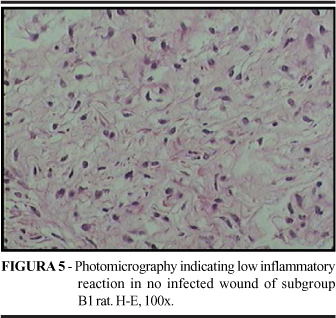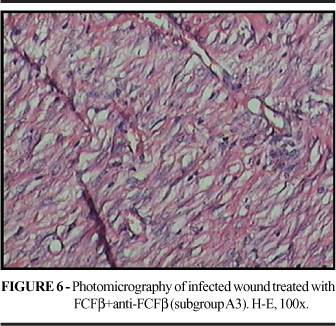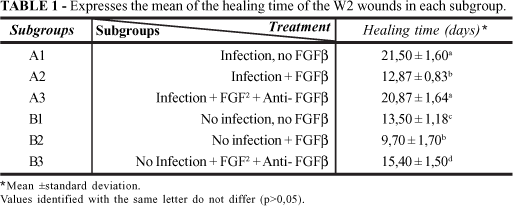Abstracts
PURPOSE: The infection is one of the main factors that affect the physiological evolution of the surgical wounds. The aim of this work is to evaluate the effects of fibroblast growth factor (FGFâ) and anti-FGFâ in the healing, synthesis and maturation of collagen when topically used on infected skin wounds of rats. METHODS: An experimental study was perfomed in 60 male Wistar rats. All animals were divided in two groups (A and B). Each group was divided in three subgroups A1, B1; A2, B2 and A3, B3. After anesthesia with pentobarbital, two open squared wounds (1cm²), 4cm distant to each other, were done in the dorsal skin of all the rats. In group A (n=30) the wounds were contaminated with multibacterial standard solution, and in group B(n=30) the wounds were maintained sterile. These wounds were named F1 (for inflammation analysis) and F2 (for collagen study). The open wounds of A1 and B1 rats were topically treated with saline solution, A2 and B2 were treated with FGFâ and subgroups A3 and B3 were treated with FGFâ and anti-FGFâ. The rats were observed until complete epitelization of F2 wounds for determination of healing time and the expression of types I and III collagen, using Picro Sirius Red staining. Inflammatory reaction in F1 wounds was studied using hematoxilineosin staining. The three variable was measured by the Image Pro-Plus Média Cybernetics software. The statistical analysis was performed by ANOVA and Tukey test, considering p<0.05 as significant. RESULTS: It was observed that infection retarded significantly (p<0.05) the time of wound scarring and the topical application of FCFb reverted the inhibition of healing caused by bacteria. The inflammatory reaction was greater in the subgroup B2 than in B1 and A3, and the difference was significant (p<0.05). It was observed greater expression of type I collagen in all the subgroups treated with FCFb, when compared with the untreated subgroups. Type III collagen was significantly decreased in wounds of B3 rats, comparing to the other subgroups. CONCLUSIONS: The FCFb accelerated the healing of open infected wounds and contributed with maturation of collagen, enhancing the type I collagen density. The anti-FCFb antibody was able to attenuate the production of both type I and III collagen.
Fibroblast growth factors; Wound healing; Skin; Infection

 Effects of the basic fibroblast growth factor and its anti-factor in the healing and collagen maturation of infected skin wound
Effects of the basic fibroblast growth factor and its anti-factor in the healing and collagen maturation of infected skin wound










